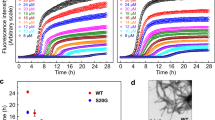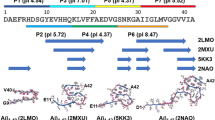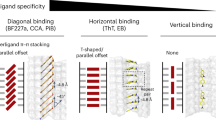Abstract
Although small molecules that modulate amyloid formation in vitro have been identified, significant challenges remain in determining precisely how these species act. Here we describe the identification of rifamycin SV as a potent inhibitor of β2 microglobulin (β2m) fibrillogenesis when added during the lag time of assembly or early during fibril elongation. Biochemical experiments demonstrate that the small molecule does not act by a colloidal mechanism. Exploiting the ability of electrospray ionization–ion mobility spectrometry–mass spectrometry (ESI-IMS-MS) to resolve intermediates of amyloid assembly, we show instead that rifamycin SV inhibits β2m fibrillation by binding distinct monomeric conformers, disfavoring oligomer formation and diverting the course of assembly to the formation of spherical aggregates. The results demonstrate the power of ESI-IMS-MS to identify specific protein conformers as targets for intervention in fibrillogenesis using small molecules and reveal a mechanism of action in which ligand binding diverts unfolded protein monomers toward alternative assembly pathways.
This is a preview of subscription content, access via your institution
Access options
Subscribe to this journal
Receive 12 print issues and online access
$259.00 per year
only $21.58 per issue
Buy this article
- Purchase on Springer Link
- Instant access to full article PDF
Prices may be subject to local taxes which are calculated during checkout








Similar content being viewed by others
References
Sipe, J.D. et al. Amyloid fibril protein nomenclature: 2010 recommendations from the nomenclature committee of the International Society of Amyloidosis. Amyloid 17, 101–104 (2010).
Chiti, F. & Dobson, C.M. Protein misfolding, functional amyloid, and human disease. Annu. Rev. Biochem. 75, 333–366 (2006).
Bernstein, S.L. et al. Amyloid-β protein oligomerization and the importance of tetramers and dodecamers in the aetiology of Alzheimer's disease. Nat. Chem. 1, 326–331 (2009).
Glabe, C.G. Structural classification of toxic amyloid oligomers. J. Biol. Chem. 283, 29639–29643 (2008).
Necula, M., Kayed, R., Milton, S. & Glabe, C.G. Small molecule inhibitors of aggregation indicate that Aβ oligomerization and fibrillization pathways are independent and distinct. J. Biol. Chem. 282, 10311–10324 (2007).
Gosal, W.S. et al. Competing pathways determine fibril morphology in the self-assembly of β2-microglobulin into amyloid. J. Mol. Biol. 351, 850–864 (2005).
Carrell, R.W. Cell toxicity and conformational disease. Trends Cell Biol. 15, 574–580 (2005).
Martins, I.C. et al. Lipids revert inert Aβ amyloid fibrils to neurotoxic protofibrils that affect learning in mice. EMBO J. 27, 224–233 (2008).
Lee, H.G. et al. Challenging the amyloid cascade hypothesis: Senile plaques and amyloid-β as protective adaptations to Alzheimer disease. Ann. NY Acad. Sci. 1019, 1–4 (2004).
Porat, Y., Abramowitz, A. & Gazit, E. Inhibition of amyloid fibril formation by polyphenols: Structural similarity and aromatic interactions as a common inhibition mechanism. Chem. Biol. Drug Des. 67, 27–37 (2006).
Regazzoni, L. et al. A combined high-resolution mass spectrometric and in silico approach for the characterization of small ligands of β2-microglobulin. ChemMedChem 5, 1015–1025 (2010).
Cohen, F.E. & Kelly, J.W. Therapeutic approaches to protein-misfolding diseases. Nature 426, 905–909 (2003).
Conway, K.A., Rochet, J.C., Bieganski, R.M. & Lansbury, P.T. Kinetic stabilization of the α-synuclein protofibril by a dopamine-α-synuclein adduct. Science 294, 1346–1349 (2001).
Feng, B.Y. et al. Small-molecule aggregates inhibit amyloid polymerization. Nat. Chem. Biol. 4, 197–199 (2008).
Lendel, C. et al. On the mechanism of non-specific inhibitors of protein aggregation: Dissecting the interactions of α-synuclein with Congo red and lacmoid. Biochemistry 48, 8322–8334 (2009).
McGovern, S.L., Caselli, E., Grigorieff, N. & Shoichet, B.K. A common mechanism underlying promiscuous inhibitors from virtual and high-throughput screening. J. Med. Chem. 45, 1712–1722 (2002).
Ladiwala, A.R., Dordick, J.S. & Tessier, P.M. Aromatic small molecules remodel toxic soluble oligomers of amyloid β through three independent pathways. J. Biol. Chem. 286, 3209–3218 (2011).
Armstrong, A.H., Chen, J., McKoy, A.F. & Hecht, M.H. Mutations that replace aromatic side chains promote aggregation of the Alzheimer's Aβ peptide. Biochemistry 50, 4058–4067 (2011).
Platt, G.W., Routledge, K.E., Homans, S.W. & Radford, S.E. Fibril growth kinetics reveal a region of β2-microglobulin important for nucleation and elongation of aggregation. J. Mol. Biol. 378, 251–263 (2008).
Routledge, K.E., Tartaglia, G.G., Platt, G.W., Vendruscolo, M. & Radford, S.E. Competition between intra-molecular and inter-molecular interactions in an amyloid forming protein. J. Mol. Biol. 389, 776–786 (2009).
Meng, F., Marek, P., Potter, K.J., Verchere, C.B. & Raleigh, D.P. Rifampicin does not prevent amyloid fibril formation by human islet amyloid polypeptide but does inhibit fibril thioflavin-T interactions: Implications for mechanistic studies of β-cell death. Biochemistry 47, 6016–6024 (2008).
Lieu, V.H., Wu, J.W., Wang, S.S.S. & Wu, C.H. Inhibition of amyloid fibrillization of hen egg-white lysozymes by rifampicin and p-benzoquinone. Biotechnol. Prog. 23, 698–706 (2007).
Li, J., Zhu, M., Rajamani, S., Uversky, V.N. & Fink, A.L. Rifampicin inhibits α-synuclein fibrillation and disaggregates fibrils. Chem. Biol. 11, 1513–1521 (2004).
Tomiyama, T., Kaneko, H., Kataoka, K., Asano, S. & Endo, N. Rifampicin inhibits the toxicity of pre-aggregated amyloid peptides by binding to peptide fibrils and preventing amyloid-cell interaction. Biochem. J. 322, 859–865 (1997).
Carazzone, C. et al. Sulfonated molecules that bind a partially structured species of β2-microglobulin also influence refolding and fibrillogenesis. Electrophoresis 29, 1502–1510 (2008).
Smith, A.M., Jahn, T.R., Ashcroft, A.E. & Radford, S.E. Direct observation of oligomeric species formed in the early stages of amyloid fibril formation using electrospray ionisation mass spectrometry. J. Mol. Biol. 364, 9–19 (2006).
Smith, D.P., Radford, S.E. & Ashcroft, A.E. Elongated oligomers in β2-microglobulin amyloid assembly revealed by ion mobility spectrometry-mass spectrometry. Proc. Natl. Acad. Sci. USA 107, 6794–6798 (2010).
Armstrong, D.W., Schneiderheinze, J., Nair, U., Magid, L.J. & Butler, P.D. Self-association of rifamycin B: Possible effects on molecular recognition. J. Phys. Chem. B 103, 4338–4341 (1999).
Kayed, R. et al. Annular protofibrils are a structurally and functionally distinct type of amyloid oligomer. J. Biol. Chem. 284, 4230–4237 (2009).
O'Nuallain, B. & Wetzel, R. Conformational Abs recognizing a generic amyloid fibril epitope. Proc. Natl. Acad. Sci. USA 99, 1485–1490 (2002).
Xue, W.F. et al. Fibril fragmentation enhances amyloid cytotoxicity. J. Biol. Chem. 284, 34272–34282 (2009).
Smith, D.P. et al. Deciphering drift time measurements from travelling wave ion mobility spectrometry-mass spectrometry studies. Eur. J. Mass Spectrom. (Chichester, Eng.) 15, 113–130 (2009).
Smith, D.P., Giles, K., Bateman, R.H., Radford, S.E. & Ashcroft, A.E. Monitoring copopulated conformational states during protein folding events using electrospray ionization-ion mobility spectrometry-mass spectrometry. J. Am. Soc. Mass Spectrom. 18, 2180–2190 (2007).
Platt, G.W., McParland, V.J., Kalverda, A.P., Homans, S.W. & Radford, S.E. Dynamics in the unfolded state of β2-microglobulin studied by NMR. J. Mol. Biol. 346, 279–294 (2005).
Tomiyama, T. et al. Rifampicin prevents the aggregation and neurotoxicity of Aβ protein in vitro. Biochem. Biophys. Res. Commun. 204, 76–83 (1994).
Borysik, A.J., Radford, S.E. & Ashcroft, A.E. Co-populated conformational ensembles of β2-microglobulin uncovered quantitatively by electrospray ionisation mass spectroscopy. J. Biol. Chem. 279, 27069–27077 (2004).
Smith, D.P., Jones, S., Serpell, L.C., Sunde, M. & Radford, S.E. A systematic investigation into the effect of protein destabilization on β2-microglobulin amyloid formation. J. Mol. Biol. 330, 943–954 (2003).
Xue, W.F., Homans, S.W. & Radford, S.E. Systematic analysis of nucleation-dependent polymerization reveals new insights into the mechanism of amyloid self-assembly. Proc. Natl. Acad. Sci. USA 105, 8926–8931 (2008).
Ladner, C.L. et al. Stacked sets of parallel, in-register beta-strands of β2-microglobulin in amyloid fibrils revealed by site-directed spin labeling and chemical labeling. J. Biol. Chem. 285, 17137–17147 (2010).
Debelouchina, G.T., Platt, G.W., Bayro, M.J., Radford, S.E. & Griffin, R.G. Magic angle spinning NMR analysis of β2-microglobulin amyloid fibrils in two distinct morphologies. J. Am. Chem. Soc. 132, 10414–10423 (2010).
Gazit, E. A possible role for π-stacking in the self-assembly of amyloid fibrils. FASEB J. 16, 77–83 (2002).
Taniguchi, S. et al. Inhibition of heparin-induced tau filament formation by phenothiazines, polyphenols, and porphyrins. J. Biol. Chem. 280, 7614–7623 (2005).
Ehrnhoefer, D.E. et al. EGCG redirects amyloidogenic polypeptides into unstructured, off-pathway oligomers. Nat. Struct. Mol. Biol. 15, 558–566 (2008).
Bieschke, J. et al. EGCG remodels mature α-synuclein and amyloid-β fibrils and reduces cellular toxicity. Proc. Natl. Acad. Sci. USA 107, 7710–7715 (2010).
Ladiwala, A.R.A. et al. Resveratrol selectively remodels soluble oligomers and fibrils of amyloid Aβ off-pathway conformers. J. Biol. Chem. 285, 24228–24237 (2010).
Grabenauer, M., Wu, C., Soto, P., Shea, J.E. & Bowers, M.T. Oligomers of the prion protein fragment 106–126 are likely assembled from beta-hairpins in solution, and methionine oxidation inhibits assembly without altering the peptide's monomeric conformation. J. Am. Chem. Soc. 132, 532–539 (2010).
Dupuis, N.F., Wu, C., Shea, J.E. & Bowers, M.T. Human islet amyloid polypeptide monomers form ordered beta-hairpins: A possible direct amyloidogenic precursor. J. Am. Chem. Soc. 131, 18283–18292 (2009).
Ashcroft, A.E. Mass spectrometry and the amyloid problem–how far can we go in the gas phase? J. Am. Soc. Mass Spectrom. 21, 1087–1096 (2010).
Kayed, R. et al. Common structure of soluble amyloid oligomers implies common mechanism of pathogenesis. Science 300, 486–489 (2003).
Laurén, J., Gimbel, D.A., Nygaard, H.B., Gilbert, J.W. & Strittmatter, S.M. Cellular prion protein mediates impairment of synaptic plasticity by amyloid-β oligomers. Nature 457, 1128–1132 (2009).
Acknowledgements
We thank A. Kalverda for advice on NMR spectroscopy, D.P. Smith for advice about α-synuclein, K. Ainley for technical assistance, C. Glabe for the gift of OC and A11 antibodies and Aβ1-40 oligomers, J. Rushworth for creating fibrillar oligomers of Aβ1-42, R. Wetzel for the gift of WO1 antibodies and the Radford and Ashcroft groups for helpful discussions and advice. We acknowledge the Wellcome Trust (grant numbers 075675 and 062164) and BBSRC (Grant Number BB/526502/1) for funding. The Synapt HDMS mass spectrometer was purchased with funding from the Biotechnology and Biological Sciences Research Council (Research Equipment Initiative grant BB/E012558/1).
Author information
Authors and Affiliations
Contributions
L.A.W. designed and carried out MS experiments, performed MS data analysis, carried out colloidal inhibition assays and wrote the paper. G.W.P. designed and carried out small-molecule screen, designed NMR experiments and performed NMR data analysis and wrote the paper. A.L.H. carried out immunological assays, cell toxicity assays and wrote the paper. S.E.R., A.E.A., S.W.H. and E.W.H. designed experiments, performed data interpretation and wrote the paper.
Corresponding authors
Ethics declarations
Competing interests
The authors declare no competing financial interests.
Supplementary information
Supplementary Text and Figures
Supplementary Methods and Supplementary Results (PDF 580 kb)
Rights and permissions
About this article
Cite this article
Woods, L., Platt, G., Hellewell, A. et al. Ligand binding to distinct states diverts aggregation of an amyloid-forming protein. Nat Chem Biol 7, 730–739 (2011). https://doi.org/10.1038/nchembio.635
Received:
Accepted:
Published:
Issue Date:
DOI: https://doi.org/10.1038/nchembio.635
This article is cited by
-
Crocus-derived compounds alter the aggregation pathway of Alzheimer’s Disease - associated beta amyloid protein
Scientific Reports (2020)
-
Protein misfolding in neurodegenerative diseases: implications and strategies
Translational Neurodegeneration (2017)
-
Attenuation of β-Amyloid Toxicity In Vitro and In Vivo by Accelerated Aggregation
Neuroscience Bulletin (2017)
-
A specific nanobody prevents amyloidogenesis of D76N β2-microglobulin in vitro and modifies its tissue distribution in vivo
Scientific Reports (2017)
-
Human Islet Amyloid Polypeptide N-Terminus Fragment Self-Assembly: Effect of Conserved Disulfide Bond on Aggregation Propensity
Journal of the American Society for Mass Spectrometry (2016)



